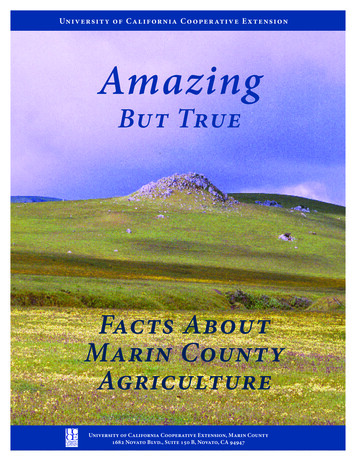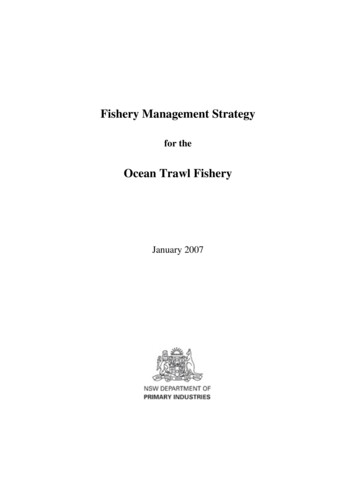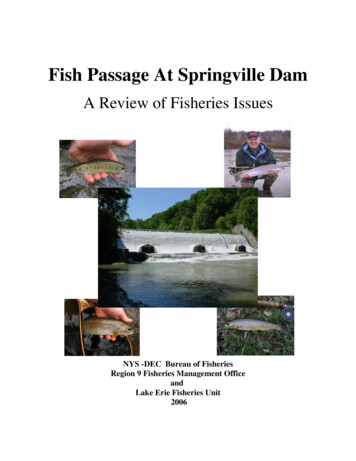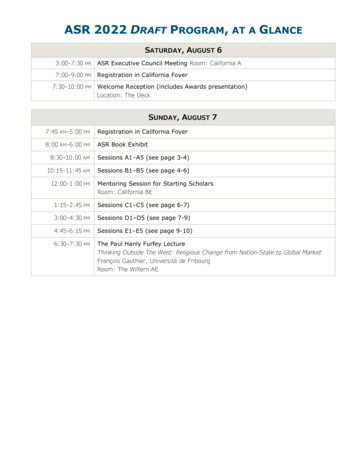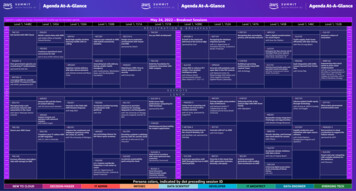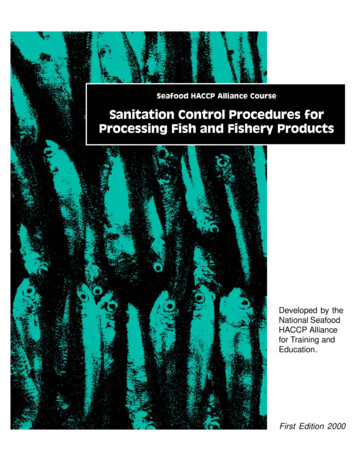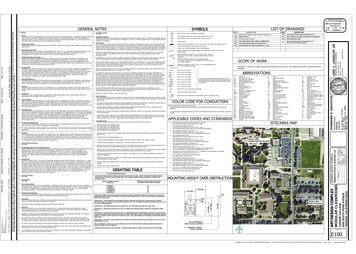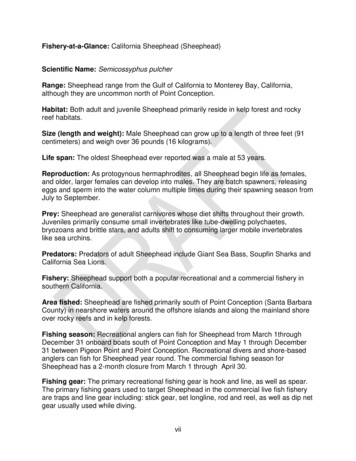
Transcription
Fishery-at-a-Glance: California Sheephead (Sheephead)Scientific Name: Semicossyphus pulcherRange: Sheephead range from the Gulf of California to Monterey Bay, California,although they are uncommon north of Point Conception.Habitat: Both adult and juvenile Sheephead primarily reside in kelp forest and rockyreef habitats.Size (length and weight): Male Sheephead can grow up to a length of three feet (91centimeters) and weigh over 36 pounds (16 kilograms).Life span: The oldest Sheephead ever reported was a male at 53 years.Reproduction: As protogynous hermaphrodites, all Sheephead begin life as females,and older, larger females can develop into males. They are batch spawners, releasingeggs and sperm into the water column multiple times during their spawning season fromJuly to September.Prey: Sheephead are generalist carnivores whose diet shifts throughout their growth.Juveniles primarily consume small invertebrates like tube-dwelling polychaetes,bryozoans and brittle stars, and adults shift to consuming larger mobile invertebrateslike sea urchins.Predators: Predators of adult Sheephead include Giant Sea Bass, Soupfin Sharks andCalifornia Sea Lions.Fishery: Sheephead support both a popular recreational and a commercial fishery insouthern California.Area fished: Sheephead are fished primarily south of Point Conception (Santa BarbaraCounty) in nearshore waters around the offshore islands and along the mainland shoreover rocky reefs and in kelp forests.Fishing season: Recreational anglers can fish for Sheephead from March 1throughDecember 31 onboard boats south of Point Conception and May 1 through December31 between Pigeon Point and Point Conception. Recreational divers and shore-basedanglers can fish for Sheephead year round. The commercial fishing season forSheephead has a 2-month closure from March 1 through April 30.Fishing gear: The primary recreational fishing gear is hook and line, as well as spear.The primary fishing gears used to target Sheephead in the commercial live fish fisheryare traps and line gear including: stick gear, set longline, rod and reel, as well as dip netgear usually used while diving.vii
Market(s): Sheephead are primarily landed commercially in the live fish fishery and soldto restaurants.Current stock status: At this time, Sheephead landings appear to be stable andpopulations appear to benefit from restricted fishing in Marine Protected Areas.Management: Sheephead are currently managed with seasonal closures, minimumbag and size limits, as well as a Total Allowable Catch for both the recreational andcommercial fisheries. The available information suggests there are currently nomanagement issues, as Sheephead populations and landings appear to be stable.viii
1 The Species1.1 Natural History1.1.1 Species DescriptionCalifornia Sheephead (Sheephead) (Semicossyphus pulcher) are one of themost common temperate wrasse species in the Labridae family in southern California.Wrasses are primarily found in tropical waters, although in addition to Sheephead thereare two other temperate wrasse species found in California, Señorita (Oxyjuliscalifornica) and Rock Wrasse (Halichoeres semicinctus). Sheephead are easilydistinguished from the other wrasse species by their large size, color pattern andprotruding canine-like teeth. Sheephead are sexually dimorphic and male, female andyoung-of-the-year individuals are easily distinguishable. Males have a black head andtail divided by a reddish color along their middle. Both sexes have a white chin, althoughfemales are uniformly reddish-pink in color. The young-of-the-year are bright reddishorange with a white stripe along their lateral line and large black spots on their reardorsal and upper caudal fins (Figure 1-1). Coloration and morphology alone is notsufficient to determine the sex of individuals, as transitioning or recently transitionedmales can appear female with uniform coloration, but possess male gonads (LokeSmith et al. 2010).Figure 1-1. Images of California Sheephead life stages a) juvenile, b) female and, c)male (Photo Credit: Miranda Haggerty, CDFW).1.1.2 Range, Distribution, and MovementSheephead range from the Gulf of California to Monterey Bay, California, but areuncommon north of Point Conception (Figure 1-2). They are considered residentspecies on the reefs they reside. Tagging studies show Sheephead have small homeranges and high site fidelity (Topping et al. 2005, 2006). On average, Sheephead homerange is approximately 600 square meters (m2) (6,458 square feet (ft2)), but this canvary seasonally with individuals moving more during warmer water temperatures.Gender may also drive some differences seen in Sheephead movement. For instance,terminal phase males expand their home ranges and move wider distances duringspawning compared to initial phase females (Lindholm et al. 2010). Although thismovement behavior is different to what was observed in an earlier study off CatalinaIsland, where terminal phase males occupied small territories approximately 20 meters1-1
(m) (66 feet (ft)) along a reef during spawning season compared to females who movedbetween various males’ spawning territories (Adreani et al. 2004). These differencesseen in movement behavior suggest like other life history characteristics of Sheephead,their movement may change with differing local environmental conditions andpopulation parameters.Figure 1-2. Range of California Sheephead.1.1.3 Reproduction, Fecundity, and Spawning SeasonSheephead are protogynous hermaphrodites, meaning they all begin life asfemales and older, larger females can develop into males. The largest female in a groupwill commonly change sex in response to the removal of the dominant male. Althoughtransformation does not always occur, changing to male depends on the sex ratio of apopulation and the size of available males (Warner 1975; Cowen 1990). Sheephead arebatch spawners, with females releasing eggs almost daily during their spawning seasonfrom July to September (Adreani et al. 2004). Fecundity increases with increasinglength and ovary mass, indicating the importance of large females for the reproductivepotential of Sheephead populations (Loke-Smith et al. 2012). The average number ofeggs spawned daily varies between studies from 12,000 to 296,000 (Warner 1975; Jirsaet al. 2007; Loke-Smith et al. 2012). The Gonadosomatic Index (GSI) (an index ofrelative gonad size compared to body weight, an estimate of reproductive allocation) ofmature females has been estimated to range between about 2 to 7%, with higher GSIbeing attributed to populations of Sheephead that consume a higher proportion ofmobile invertebrates like sea urchins (Hamilton et al. 2011).After spawning occurs, fertilized eggs enter the plankton as pelagic larvae for 34to 78 days. Most Sheephead larvae settle at approximately 37 days, but some areslower growing and continue as pelagic larvae for another month until they reachsettlement size between 0.5 and 0.6 inches (in) (13.0 to 16.0 millimeters (mm)). Oncelarvae settle onto shallow reefs, continued growth of young-of-the-year individuals is notaffected by their size or age at settlement (Cowen 1991).1-2
1.1.4 Natural MortalityDetermining the natural mortality (M) of marine species is important forunderstanding the health and productivity of their stocks. Natural mortality results from allcauses of death not attributable to fishing such as old age, disease, predation orenvironmental stress. Natural mortality is generally expressed as a rate that indicates thepercentage of the population dying in a year. Fish with high natural mortality rates mustreplace themselves more often and thus tend to be more productive. Natural mortalityalong with fishing mortality result in the total mortality operating on the fish stock.The oldest Sheephead ever reported was a male at 53 years (yr) (Warner 1975).Although this is most likely uncommon, since a size at age study using dorsal spinesfound fish were 21 yr old at most (Cowen 1990). Determining the natural mortality (M) offish is important in understanding the health and productivity of their stocks. Naturalmortality of a fish results from all causes of death not attributable to fishing such as oldage, disease, predation, environmental stress. Natural mortality is generally expressedas a rate that indicates the percentage of the population dying in a year. Fish with highnatural mortality rates must replace themselves more often and thus tend to be moreproductive. Natural mortality, along with fishing mortality, result in the total mortalityoperating on the fish stock. A large proportion of the uncertainty in the 2004 stockassessment is due to the uncertainty in the estimate of natural mortality, as estimates ofbiomass and recruitment are highly dependent on this value. Estimating natural mortalityis difficult and often relies on evaluation of life history traits. The natural mortality ofSheephead has been estimated between M 0.2 and 0.35 using age and growthparameters, L and K, maximum length and the relative growth rate of an individual,described in detail below (Alonzo et al. 2004.)1.1.5 Individual GrowthIndividual growth of marine species can be quite variable, not only amongdifferent groups of species but also within the same species. Growth is often very rapidin young fish and invertebrates, but slows as adults approach their maximum size. Thevon Bertalanffy Growth Model is most often used in fisheries management, but othergrowth functions may also be appropriate.Male Sheephead can grow up to a length of 3 ft (91 centimeters (cm)) and weighover 36 pounds (lb) (79 kilograms (kg)). Female Sheephead grow to an average of 14.5in (37.0 cm) in length before changing sex to male. However, there is record of a femaleaged at 30 yr that weighed 18.3 lb (8.3 kg) with an unknown length (Fitch andLavenberg 1971). Individual growth of fishes is quite variable, not only among differentgroups of species, but also within the same species. Growth is often very rapid in youngfish and invertebrates, but slows as adults approach their maximum size. The vonBertalanffy Growth Model is most often used in fisheries management, but other growthfunctions may also be appropriate. Alonzo et al. 2004 conducted a stock assessmentthat used four different methods for fitting growth parameters to predict observed growthdata. Growth parameters for Sheephead have been calculated for both sexes combinedby fitting data to a von Bertalanffy Growth Model:1-3
𝐿𝑡 𝐿 (1 𝑒 𝑘(𝑡 𝑡0 )where Lt length at age, L maximum asymptotic length, k relative growth rate, t age of fish, and t0 theoretical age at time when length is zero. The values of thosecalculated parameters are: L 467.7, k 0.182, t0 0. The relationship between weightand length for Sheephead (both sexes combined) has also been modeled using theexponential equation:𝑊𝐿 α𝐿𝛽where W is the weight in grams, L is the length in centimeters, and 𝛼 and 𝛽 areestimated parameters. The parameters for Sheephead are estimated at 𝛼 0.00000002952 and 𝛽 2.9066 (Recreational Fisheries Information Network(RecFIN)).1.1.6 Size and Age at MaturitySheephead reach maturity at approximately 4 yr of age, and a total length ofabout 10 in (25 cm) (Warner 1975). However, there is a wide range of individualvariation among different populations (Cowen 1990; Caselle et al. 2011). Transitioningto male typically occurs at approximately 7 to 8 yr or 14.5 in (37 cm) in length, but it canoccur in Sheephead as young as 4 yr or 9 in (22 cm) (Warner 1975; Cowen 1990). Theaverage size at maturity and age at sex change has been seen to decrease inSheephead populations surrounding the Channel Islands (Hamilton et al. 2007, 2011).This decrease in size is suggested to be from increased fishing pressure, aspopulations of Sheephead in Mexico where fishing pressure has remained low over timeexhibit no change in size structure or shift in maturity or sex change (Hamilton et al.2007).1.2 Population Status and DynamicsAlthough a formal stock assessment for Sheephead has not been conducted since2004, only three years after regulations were put in place, Sheephead appear to havebenefited from the regulations. At this time, Sheephead landings appear to be stable(see section 1.2.1), and populations also appear to benefit from restricted fishing inMarine Protected Areas (MPA).1.2.1 Abundance EstimatesA stock assessment that estimated the Spawning Potential Ratio (SPR) ofmature Sheephead was approximately 20% of the unfished biomass level (Alonzo et al.2004). Female biomass in isolation was estimated to be impacted much less, withfemale SPR estimated at 80% of the unfished level (Alonzo et al. 2004). It is importantto note that most of the biological data used in the 2004 stock assessment was1-4
collected before the effects of the size and catch limits set between 1999 and 2001could be observed, and should be updated to reflect current landings. Additionally sincethe 2004 stock assessment, research has indicated high variability in life historyparameters between Sheephead populations across southern California, andabundance estimates may vary greatly depending on each population’s exposure tovarying fishing pressures and environmental conditions.Little is known about historical abundances of Sheephead before commercialfishing began, although a recent study using zooarchaeological records suggestsSheephead stocks may have thrived more than 10,000 yr ago and prehistoric stock sizehas decreased by approximately 14.6% compared to Sheephead today (Braje et al.2017). Research has shown Sheephead display biogeographic patterns of abundancewith densities highest in the southern portion of their range (Cowen 1985; Hamilton etal. 2007; Caselle et al. 2011;). Densities are also different between island and mainlandlocations, with an average of 2.84 0.33 fish per 80 cubic meter (m3) (2,825 ft3) atoffshore islands and 1.84 0.27 fish per 80 m3 (2,825 ft3) along the mainland (Caselleet al. 2011).1.2.2 Age Structure of the PopulationThe current age structure of retained recreational catch of Sheephead wasdetermined by length data that was converted to ages (Figure 1-3) (RecFIN). Theimplementation of the minimum size limit in 2001 is reflected in the shift in the agestructure of the catch with decreasing proportion of fish under 6 yr of age. Since 2001,the majority of the catch has been fish from 7 to 14 yr of age, totaling 88%. AsSheephead mature near 4 yr of age, this means the majority of the fished populationreproduced a minimum of three times. Each of the ten age classes are represented inthe catch every year, which suggests a healthy population has existed without anyyears of recruitment failure.1-5
Figure 1-3. Age structure of recreational California Sheephead catch from 1980 to 2017.Age classes were converted from length data of retained catch from all fishing modes.All fish older than 15 yr and younger than 5 yr are represented in summed categories(no data collected from 1990 to 1992) (RecFIN).1.3 HabitatBoth adult and juvenile Sheephead primarily reside in kelp forest and rocky reefhabitats, and they are highly associated with the structure of these habitats. Newlysettled juveniles are most commonly found on reefs with high relief, and they arecommonly found in areas with protective ledges leading out to open habitat for refugeand foraging (Andrews and Anderson 2004). Adult Sheephead are found in higherdensities on connected or continuous reefs compared to isolated reefs (Sievers et al.2016). Although adult Sheephead may forage up to 65 to 100 ft (20 to 30 m) away fromthese structures during the day, they return to the reef for refuge at sunset, where theyare often found resting under rocks and crevices until daylight (Love 2011).1.4 Ecosystem RoleIt has been suggested that Sheephead play an important ecosystem role in themaintenance of kelp forest habitat through the regulation of urchin populations (Cowen1983; Hobson and Chess 1986; Hamilton and Caselle 2015; Selden et al. 2017). At highdensities, both red (Mesocentrotus franciscanus) and purple (Strongylocentrotuspurpuratus) urchins can overgraze giant kelp and other macroalgae, converting thestructural habitat into a deforested area overrun by sea urchins. This occurrence istermed an urchin barren (Estes and Duggins 1995; Graham 2004). The presence oflarge Sheephead consuming urchins may prevent kelp forests from becoming urchin1-6
barrens. This is a vital ecosystem role as over 200 species of fishes, invertebrates andmammals rely on kelp forests for structural habitat in southern California alone (Fosterand Schiel 1985). The presence of Sheephead may also benefit the kelp forestcommunity by removing parasites as juvenile Sheephead have been observed toengage in cleaning behaviors, removing and consuming parasites from the skin ofassociated fishes (Coyer 1980; Allen et al. 2006).1.4.1 Associated SpeciesThe species most highly associated with Sheephead comprise the complex ofsouthern ranging kelp and rocky reef associated species including Blacksmith (Chromispunctipinnis), Halfmoon (Medialuna californiensis), Garibaldi (Hypsypops rubicundus),Opaleye (Girella nigricans), Treefish (Sebastes serriceps) and Giant Sea Bass(Stereolepis gigas) (Allen et al. 2006).1.4.2 Predator-prey InteractionsSheephead are generalist carnivores whose diet shifts throughout their growth.They consume small invertebrates like polychaetes, bryozoans and brittle stars in thejuvenile stage and then shifting to larger mobile invertebrates like sea urchins as theyincrease in size (Cowen 1983). Shifts in prey consumption can also be seen betweenSheephead populations across southern California depending on Sheephead size andprey availability (Hamilton et al. 2011). Sheephead feeding on red and purple seaurchins may play an important role in regulating urchin densities with larger malesexerting top down control on urchin populations (Cowen 1983; Hobson and Chess1986; Hamilton and Caselle 2015). Feeding trials show Sheephead smaller than 8 in(20 cm) do not consume urchins, and larger Sheephead consume disproportionallymore and larger urchins (Selden et al. 2017). Additionally as urchin size increasesSheephead must be larger for successful predation. For large urchins from 2.0 to 2.8 in(5.1 to 7.1 cm) test diameter, only Sheephead over 18 in (46 cm) were successful inmore than half of predation attempts, whereas Sheephead less than 11 in (28 cm) wereonly successful in 10% of their attacks (Selden et al. 2017). The importance of largerSheephead to regulate urchin populations has also been observed in a Sheepheadpopulation surrounding San Nicolas Island, when their size structure recovery causedchanges in their diet from small, sessile invertebrates to invertebrates like urchins(Hamilton et al. 2014). These studies demonstrate the role of Sheephead controllingurchin populations relies on large individuals rather than an abundance of smallindividuals. MPAs may aid in Sheephead regulating urchin densities, as multiple studieshave shown a higher biomass of large Sheephead inside reserves corresponding withincreased urchin mortalities rates (Froeschke et al. 2006; Caselle et al. 2011; Hamiltonand Caselle 2015; Selden et al. 2017). Although recent observations demonstratesmaller females, from 9 to 12 in (23 to 30 cm), can actually use rocks as anvils to breakopen large urchins that are too big to be crushed by their mouths alone (Dunn 2016).Predators of adult Sheephead include Giant Sea Bass, Soupfin Sharks(Galeorhinus galeus) and California Sea Lions (Zalophus californianus) (Allen et al.2006). Juveniles are most likely consumed by larger kelp forest fishes found in thesame kelp forest and rocky reef habitats.1-7
1.5 Effects of Changing Oceanic ConditionsOceanic changes due to climatic events impacting water temperature andnutrient availability such as El Niño Southern Oscillation (ENSO), the Pacific DecadalOscillation (PDO) and the North Pacific Gyre Oscillation (NPGO) can have profoundeffects on fishes and fisheries. There may be long-term positive responses bySheephead populations migrating into warm water regimes, as their northern range toMonterey Bay is likely a relatively modern phenomenon as increasing warming eventsmay increase the range of larval dispersal and survivorship (Cowen 1986; Braje et al.2017). With increasing climatic events the Sheephead’s range may continue to expandor the center of the population in southern California may shift northward.1-8
2 The Fishery2.1 Location of the FisherySheephead are fished primarily south of Point Conception (Santa BarbaraCounty) in nearshore waters around the offshore islands and along the mainland shoreover reefs and in kelp with over 95% of the landings occurring in this area (Figure 2-1).Landings of Sheephead occur north of Point Conception where they are bycatch in thenearshore fishery, with two-thirds of the landings being 10 lb (4.5 kg) or less.Figure 2-1. Maps showing location of a) recreational Sheephead catch and b)commercial Sheephead landings, 1999 to 2017. The commercial graph also shows theNFP regions where Sheephead occur (Commercial Passenger Fishing Vessel (CPFV)Logs and CDFW Marine Landings Database System (MLDS)).2.2 Fishing Effort2.2.1 Number of Vessels and Participants Over TimeIn 1996, due to concerns about the growing live fish trap fishery in southernCalifornia, the Legislature established a nontransferable Finfish Trap Permit for the takeof finfish south of Point Arguello (Santa Barbara County). In 1996, 288 Finfish TrapPermits were sold.Concerns about the coast-wide growing live fish fishery led to the NearshoreFisheries Management Act (NFMA) of 1998 (FGC §8585 et. seq.) that was part of theMLMA (FGC §7055 et. seq.). The NFMA established the Nearshore Fishery Permit(NFP) for the take of Cabezon, Sheephead, California Scorpionfish, Greenlings(Hexagrammos spp.), and Black-and-Yellow (Sebastes chrysomelas), China (Sebastesnebulosus), Gopher (Sebastes carnatus), Grass (Sebastes rastrelliger) and Kelp(Sebastes atrovirens) Rockfishes, with 1,127 permits issued in 1999. Additionally, 158Finfish Trap Permits were sold in 1999 (CDFW).2-1
In 2000, the Commission adopted an annual permit renewal requirement cappingparticipation at 1,007 NFPs statewide (146 Finfish Trap Permits) (CDFW). Then in 2001the Commission adopted a minimum landings requirement of 100 lb (45 kg) from 1994to 1999, reducing the number of NFPs to 746 (123 Finfish trap permits) (CDFW).Finally in 2003, the Commission adopted a restricted access program thatcapped the number of NFPs at 220 coast wide and made them regional, with 75 and 77NFPs in the South-Central Coast and South Coast Regions, respectively (CDFW).Approximately 97% of Sheephead are caught in the South Coast Region, with theremainder coming from the South-Central Coast Region where they are caughtincidentally. A nearshore trap endorsement was established as part of the restrictedaccess program in 2003, and as a result the Finfish Trap Permit was no longer required(§150.03, Title 14, CCR). Since 2003, the number of NFPs has declined to 141statewide in 2018, with 51 in the South-Central and 50 in the South Coast Regions. Thedecline in permits is primarily due to a two-for-one permit transfer system that changedto one-for-one or to nonrenewal on April 1, 2018 (§150, Title 14, CCR).The live fish fishery began around 1987 (McKee 1993) and as it grew, so did thenumber of Sheephead fishers, peaking at 455 in 1996 (Figure 2-2). The number ofparticipants dropped to less than 100 after the restricted access program wasestablished in 2003, and has averaged 60 participants since 2010 (CDFW).Approximately half the South Coast Region NFP holders target Sheephead, accountingfor 95% of the landings.LandingsSouth-CentralSouthNumber fishers350300350NFP first requiredNFP restricted access250300250200200150150100100505000Landings (thousand lb)4001987 1990 1993 1996 1999 2002 2005 2008 2011 2014 2017YearFigure 2-2. Number of fishers by region (left axis: lines) and total landings (right axis:bars) in the commercial Sheephead fishery, 1987 to 2017 (CDFW MLDS).Vessels in the commercial Sheephead fishery vary from small kayaks and skiffsto trap vessels capable of fishing out at the offshore islands. Vessel size ranges from 132-2
to 56 ft (4 to 17 m), according to Department vessel license records (note that vesselswithout engines (e.g., kayaks) are not licensed). Larger vessels have one or more livewells onboard with recirculating sea water to keep the fish alive. Smaller vessels mayhave a live well, although many just have a basket or trap hung over the side to keepthe fish alive.2.2.2 Type, Amount, and Selectivity of GearNFP holders targeting Sheephead can use hook and line gear, including: rod andreel, set longline, stick gear, as well as dip net gear, which is usually used while diving.Fishers targeting nearshore species using hook and line gear are limited to 150 hookswith no more than 15 hooks per line when operating within 1 mi (1.6 km) of themainland shore (§150.17, Title 14, CCR). Stick gear is a popular gear that uses a pieceof rebar for weight and has a groundline attached to the rebar with one-hook gangionsattached to the ground line (Figure 2-3), and it is buoyed at one or both ends. Fisherstend to put out several pieces of stick gear, and closely tend their gear, checking thelines for fish every few hours.Figure 2-3. Image of stick gear with four hooks attached to a ground line along a pieceof rebar with buoy attached used in the Sheephead fishery. (Photo credit: CDFW).NFP holders with a nearshore trap endorsement can also use trap gear to takeSheephead and other NFP species. Fishers targeting Sheephead or other nearshorespecies are limited to 50 traps within state waters or 3.0 mi (5 km) along the mainlandshore. Additionally, finfish traps have a minimum mesh size of 2.0 by 2.0 in (5 by 5 cm)and can only be fished during daylight hours (FGC §9001.7).The preferred bait type in Sheephead traps is: crustaceans (rock crabs (Cancerspp.) or spider crabs (Loxorhynchus spp.)) or mollusks (mussels (Mytilus spp.)) orMarket squid (Doryteuthis opalescens) (McKee 1993). Live fish trap fishers are notallowed to use Spiny Lobster (Panulirus interruptus) or Dungeness crab (Cancermagister) as bait, and the use of rock crabs requires the fisher have a rock crab permit(FGC §9001.7). Fishers using trap gear also tend to closely monitor their gear, checkingtraps every few hours. The reason for closely monitoring their gear, be it stick gear or2-3
traps, is to ensure healthy, live fish for market; the longer fish are hooked or captured intraps the more stressed they become and the more likely that predators can harm thefish.Before the advent of the live fish fishery in the late 1980s, Sheephead werecaught primarily with gill net gear. As the demand for live fish increased, fishersswitched to trap and hook and line gear (Figure 2-4). The Marine Resources ProtectionAct of 1990 prohibited the use of gill net gear in waters less than 70 fathoms (fm) (128m) or 1.0 mi (1.6 km) around the Channel Islands and within 3 nautical miles (8 km) ofthe mainland shore from Point Arguello to the U.S. and Mexico border (FGC §8610.2),phasing in these restrictions between 1991 and 1994. This pushed gill net gear intodeeper waters resulting in the decline in the use of gill nets to take Sheephead. Therestricted access program began in 2003, which further limited gear to trap, hook andline and dip net, used while diving (§150 and 150.03, Title 14, CCR). Since 2003, 82%of the Sheephead were caught with traps, 17% with hook and line gear, and 1% with dipnets. Less than 1% were caught with gill net or trawl gear by those with a NearshoreFishery Bycatch Permit (NFBP), which allows small amounts of incidentally caught NFPspecies with trawl or gill net gear (§150.05, Title 14, CCR). NFBP holders are limited to25 or 50 lb (11 or 23 kg) per day of nearshore species, including Sheephead, in theSouth-Central and South Coast Regions, respectively, in addition to state and federalbimonthly trip limits.TrapHook-and-lineDip netGill netTrawlUnknownPercent of total catch100%80%60%40%20%0%1987 1990 1993 1996 1999 2002 2005 2008 2011 2014 2017YearFigure 2-4. Proportion of commercial Sheephead landings by gear type, 1987 to 2017(CDFW MLDS).There have been two commercial sampling programs collecting information onSheephead. The first is a Department sampling program from 1993 through 2005 thatcollected biological data (e.g., length, weight, sex, maturity and otoliths) for severalspecies, including Sheephead. The second is a Pacific States Marine Fisheries2-4
Commission (PSMFC) commercial sampling program from 1980 to present collectingbiological data (e.g., length, weight, sex, maturity and otoliths) for groundfish (primaryfocus) and Sheephead (California Cooperative Commercial Groundfish SurveySampling Manual). It should be noted that weight data for line-caught Sheephead wassparse in the Department dataset (n 5) and nonexistent in the PSMFC data set;therefore, it was not used in any analyses. Analysis of weight and length frequenciesfrom both sampling programs reveals that the majority of Sheephead in the commercialtrap fishery were from 1.0 to 2.0 lb (0.5 to 1.0 kg) and from 13 to 16 in (33 to 41 cm)Total Length (TL) (Figure 2-5 and 2-6). Sheephead caught in fish traps have a fairlynarrow size range because fish traps have semi-rigid entrance funnels that limit themaximum size of fish that can swim into the traps, and escape ports that allow smallerfish to escape. However, hook and line gear are less selective, as seen in the muchwider distribution of lengths of fish sampled in both commercial sampling programs(Figure 2-6). In 1999 the minimum size limit was 12 in (31 cm) TL (FGC §8588), whichwas changed in 2000, to 13 in (33 cm) TL where it remains (§150.16, Title 14, CCR)
viii Market(s): Sheephead are primarily landed commercially in the live fish fishery and sold to restaurants. Current stock status: At this time, Sheephead landings appear to be stable and populations appear to benefit from restricted fishing in Marine Protected Areas. Management: Sheephead are currently managed with seasonal closures, minimum bag and size limits, as well as a Total Allowable .
